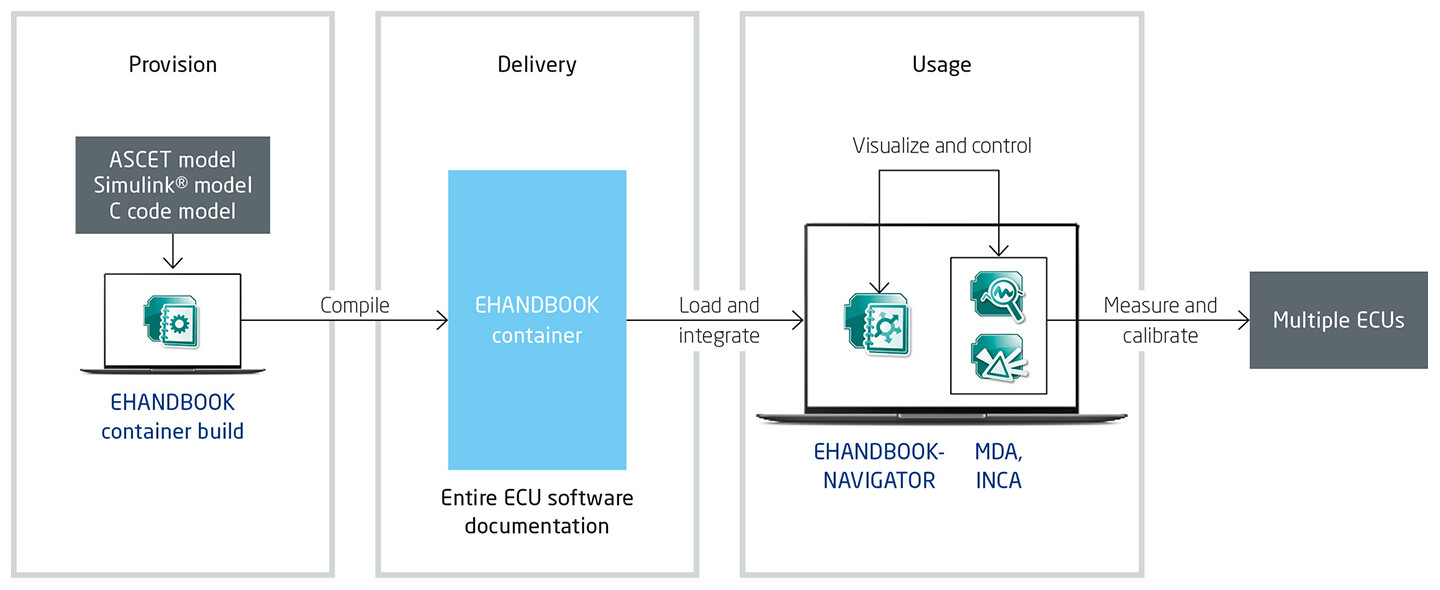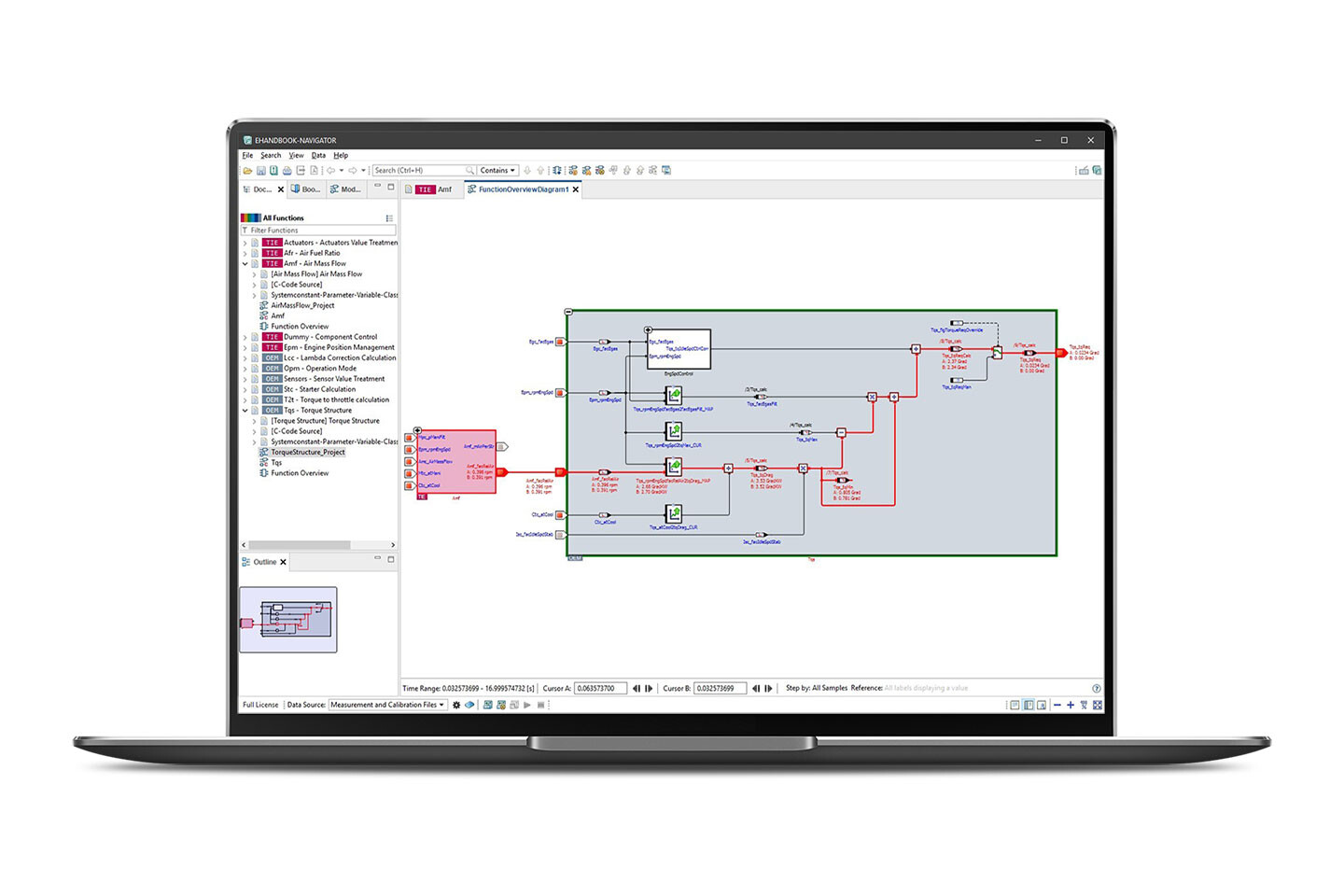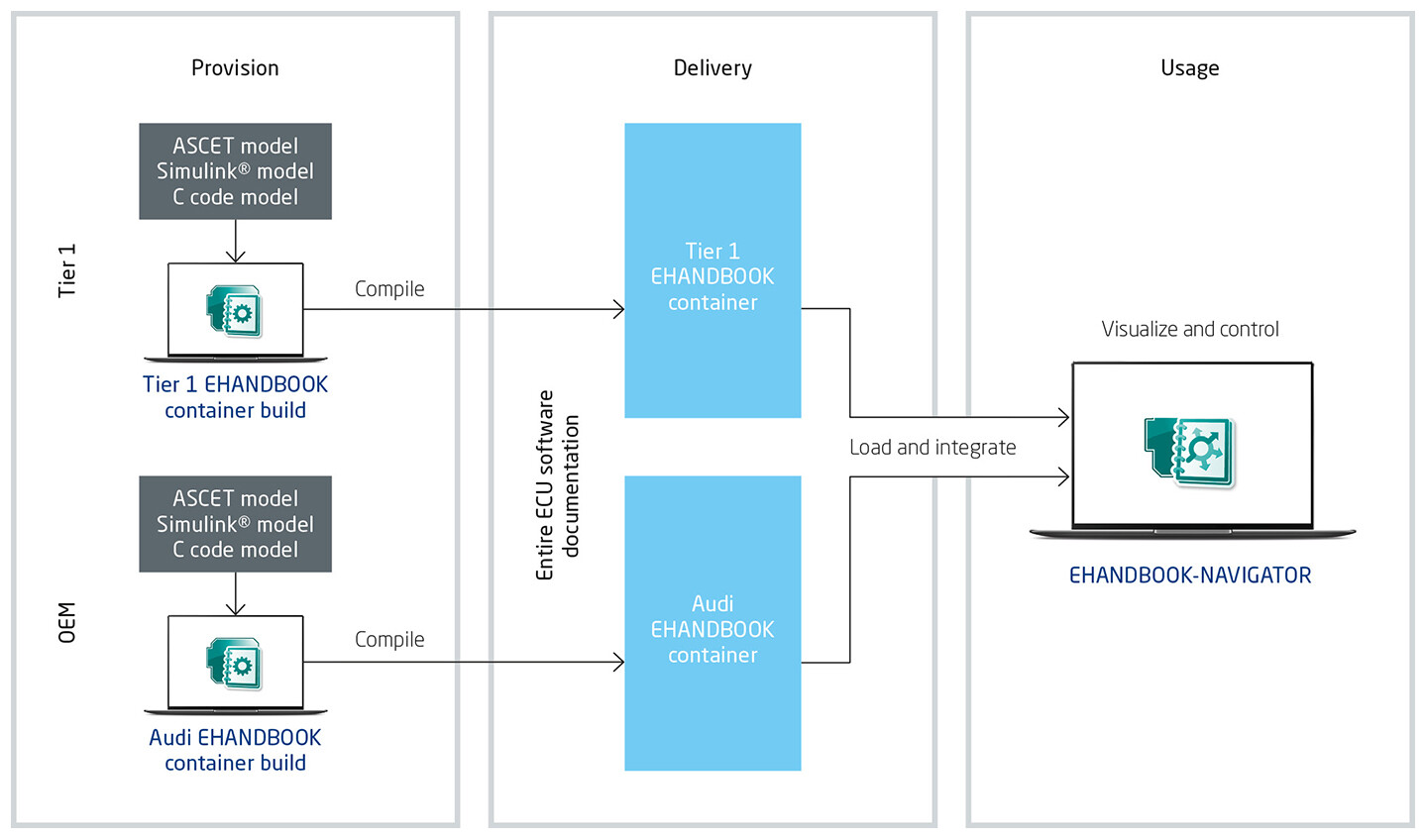A journey of discovery through ECU software
How EHANDBOOK makes calibration more efficient

With the growing scale and complexity of ECU software in recent years, understanding signal flows and dependencies in ECU software has become an increasingly difficult and time-consuming task. In the field of ECU calibration, many automakers use ETAS EHANDBOOK as a form of interactive documentation that enables them to gain a better and faster understanding of how the ECU software works. In this article, two users from Audi, Christophe Fauqueux and Patrick Nohe, and ETAS expert Dr. Patrick Frey explain how EHANDBOOK can be used to make day-to-day work more efficient.
Background
Recent years have seen steady growth in both the scale and complexity of powertrain ECU software. This trend is driven not only by the increase in ECU functions, but also by ECU connectivity and the rising tide of electrification and hybridization. A plethora of vehicle models and variants has also led to a steady increase in the time and effort required for calibration. There is a wide range of use cases, each requiring detailed knowledge of how the ECU software works, hence the need for appropriate documentation. The knowledge required for this purpose is provided by function and software development units. Besides the documentation for ECU software developed in-house, Audi also requires corresponding documentation for purchased software components, which must be made available by the individual supplier in each case.
A step up from the standard PDF format
Over time, PDF documents became firmly established as the de facto format for ECU software documentation in the automotive sector. However, as the volume of documentation has continued to increase, this file format has become increasingly unmanageable. One of the biggest challenges is working with multiple PDF files at the same time, especially since the content of each document tends to be substantial, with files typically running to several thousand pages.
An added difficulty is the absence of interlinking between individual PDF documents, which makes overall navigation more difficult. The most important content – graphical representations of the ECU software in the form of screenshots of the ASCET or Simulink® models – is broken apart across multiple separate pages in A4 format. This makes the task of following signal paths difficult and time-consuming, with users having to constantly scroll from one page to the next.
EHANDBOOK at Audi: a standard tool in the making
ETAS’ EHANDBOOK solution offers a new approach to ECU documentation (Fig. 1). Many users have quickly recognized EHANDBOOK’s advantages and potential: by providing an integrated graphical visualization of all the ECU software functions in the form of interactive models, it helps users to comprehend dependencies much faster and simplifies the task of following signal paths. Thanks to its seamless interoperability with the ETAS measurement and calibration tools INCA and MDA 8, EHANDBOOK also supports standard workflows. In 2015, Audi tailored EHANDBOOK to its in-house ECU software. Since then, the solution has been used in numerous calibration projects and established itself as a standard tool.

Significant time savings in typical use cases
As long-time users, Christophe Fauqueux and Patrick Nohe from Audi’s Neckarsulm plant have extensive experience in working with EHANDBOOK on a day-to-day basis. The two calibration experts have seen their work become more and more complex in recent years, especially with Audi’s adoption of new powertrain solutions. Patrick Nohe works on a steady stream of new and modified hybrid drive functions and must familiarize himself with each new development. Christophe Fauqueux works on fuel cell development in collaboration with other experts. Their goal is to move this technology toward a production-ready solution. This requires the technology to be re-engineered and calibrated from scratch.

A much faster way to comprehend ECU functions
A fundamental understanding is key to familiarizing oneself with ECU functions. With its user-friendly interface and seamless graphical overviews of ECU software, EHANDBOOK provides the necessary clarity. Helpful features include a cross-functional display that shows individual ECU functions within an overall context. This makes it easier to identify the origin of specific signals and determine which functions they affect, even when searching across multiple software components prepared separately by in-house development departments or external suppliers (Fig. 2).
Compared to the previous method of working with PDF files, EHANDBOOK helps users familiarize themselves with ECU functions up to 50 percent faster and identify signal origins up to 75 percent faster.
A much faster way to locate measurement signals and calibration parameters
Engineers frequently have to look up information on the meaning of measurement signals and the values of calibration parameters. A major advantage of EHANDBOOK is the rapid access it provides to the relevant information. In a typical procedure where the INCA experiment has to be opened to display the data, EHANDBOOK saves users a great deal of time, allowing them to get the job done in just 25 percent of the time it would normally take.
A much faster way to identify the causes of errors
Often, ECU software does not behave as it should during the development process. The causes of errors are many and varied, and experts argues that attempting to identify the causes during calibration is an inherently difficult task. “You’re stepping into unknown territory every time,” says Christophe Fauqueux. To remedy this, EHANDBOOK-NAVIGATOR and MDA 8 have been specially designed to work together to enable seamless operation. Thanks to powerful measurement technology (FETK), engineers can measure very large numbers of signals on test-drives. The measurement data file is loaded in MDA 8 and the time stamp at which the error occurred is highlighted with the cursor. This time stamp is transferred directly to EHANDBOOK and the measured values along the signal path are annotated. Based on the signal for which the error was observed, the entire chain of calculations and decisions made by the software can then be traced. “You don’t have to spend ages searching because the correlations between the calculations are immediately apparent,” says Christophe Fauqueux. This reduces the time spent on troubleshooting by up to 75 percent.
A much faster way to understand interactions between functions
It is very often necessary to calibrate functions that stem from various in-house development departments as well as from external suppliers. In such cases, the documentation that corresponds to each function is provided separately. “Trying to comprehend the overall context from multiple PDF documents is a hugely laborious task. This is where we can benefit from EHANDBOOK’s ability to load and consolidate multiple EHANDBOOK files,” say the Audi experts. By linking all these files into a single, coherent overview, cross-functional dependencies can be displayed clearly and transparently. This leads to time savings of between 20 and 80 percent depending on the project phase and the quality of the content (Fig. 3).

Summary
EHANDBOOK users can benefit from considerable time savings. A better understanding of ECU software can also help to avoid errors, leading to corresponding improvements in the quality of calibration results.
Audi experts help shape further development
For Patrick Nohe and Christophe Fauqueux, one of EHANDBOOK’s most important features is the ability to represent the ECU software in a graphical form. The seamless display of signal paths across ECU functions makes interrelationships much easier to understand. EHANDBOOK offers even more potential for improvement in this area, for example in regard to saving and forwarding model views. Experts will therefore continue to support the further development of EHANDBOOK in the future, contributing their expertise and feedback in the context of user research and concept validation. Besides applying EHANDBOOK to traditional powertrain ECUs, Audi has now also started using it in other domains. Other suppliers are also gradually making EHANDBOOK container files available.
Interviewees
Christophe Fauqueux is an expert in the development of calibration and fuel cell functions at Audi AG.
Patrick Nohe is an expert in the calibration of driving behavior for V diesel engines at Audi AG.
Dr. Patrick Frey is a Senior Product Manager at ETAS GmbH. He is responsible for the EHANDBOOK solution.
Further information
-
 A journey of discovery through ECU software: How EHANDBOOK makes calibration more efficient Download
A journey of discovery through ECU software: How EHANDBOOK makes calibration more efficient Download